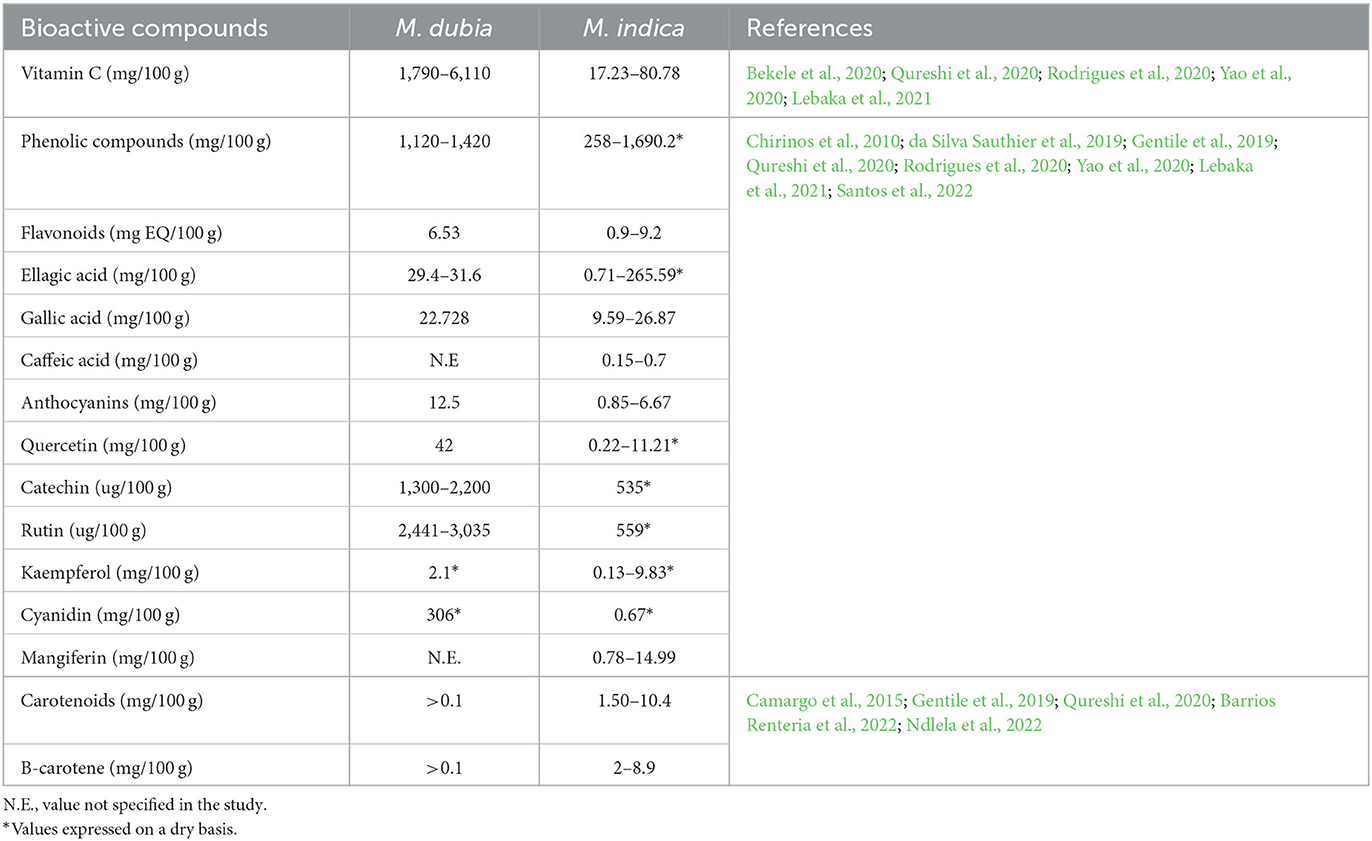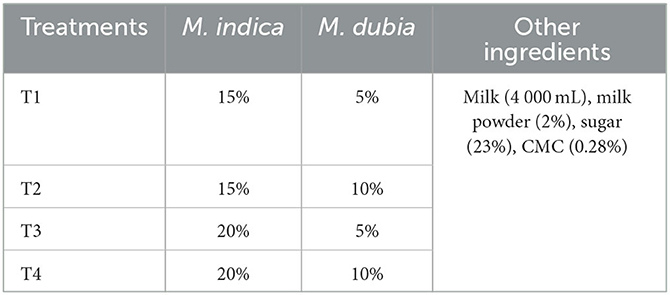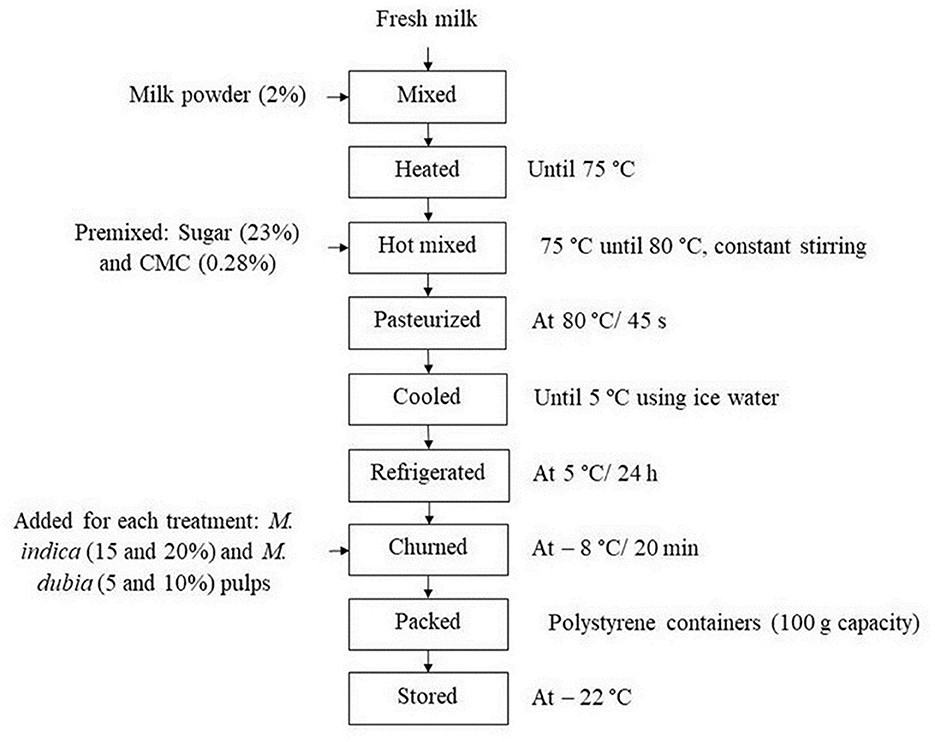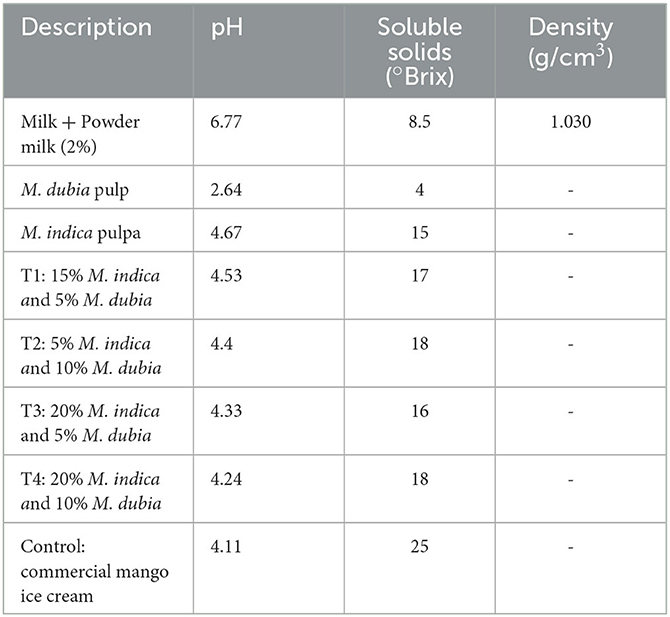- 1Laboratory Functional Food and Bioprocessing, Department of Food Industries, Universidad Nacional de Frontera, Sullana, Peru
- 2Faculty of Business Sciences and Tourism, Universidad Nacional de Frontera, Sullana, Peru
- 3Professional School of Engineering in Food Industries, Universidad Nacional Autónoma de Tayacaja Daniel Hernández Morillo, Huancavelica, Peru
Ice cream is a widely consumed product in the world. Unfortunately, its standard presentation is very poor in nutraceuticals; fruits such as Mangifera indica and Myrciaria dubia have an important bioactive potential, which can be used to enrich this type of product in phytochemicals. However, maintaining the health and sensory aspects of a functional ice cream is still under investigation. The influence of Mangifera indica and Myrciaria dubia pulp on the bioactive and sensory properties of ice cream was studied. Four ice cream treatments were prepared with Mangifera indica (15% and 20%) and Myrciaria dubia (5% and 10%). Ascorbic acid content (reduction of 2,6 dichlorophenolindophenol), total phenolic content (Folin-Ciocalteu reaction) and antioxidant capacity (DPPH radical inhibition) were evaluated in addition to a sensory sorting test. The treatments with 10% Myrciaria dubia showed the highest ascorbic acid contents (83.46 and 71.27 mg/100g), total phenolic compounds (80.10 and 79.06 mgGAE/100g) and antioxidant capacity (61.0 and 64.05 mg ice/ml solvent) compared to the 5% treatment and the control; while the influence of Mangifera indica on these parameters was relatively minor. However, sensory evaluation showed that T3 (5% Myrciaria dubia; 20% Mangifera indica) were the most preferred, outperforming the control ice cream. It is evident that Myrciaria dubia stands out for its high ascorbic acid content, total phenolic compounds and antioxidant capacity of the ice cream while Mangifera indica improves its sensory aspect, allowing an overall balance of sweet-acid taste pleasant to the consumer and maintaining its health properties.
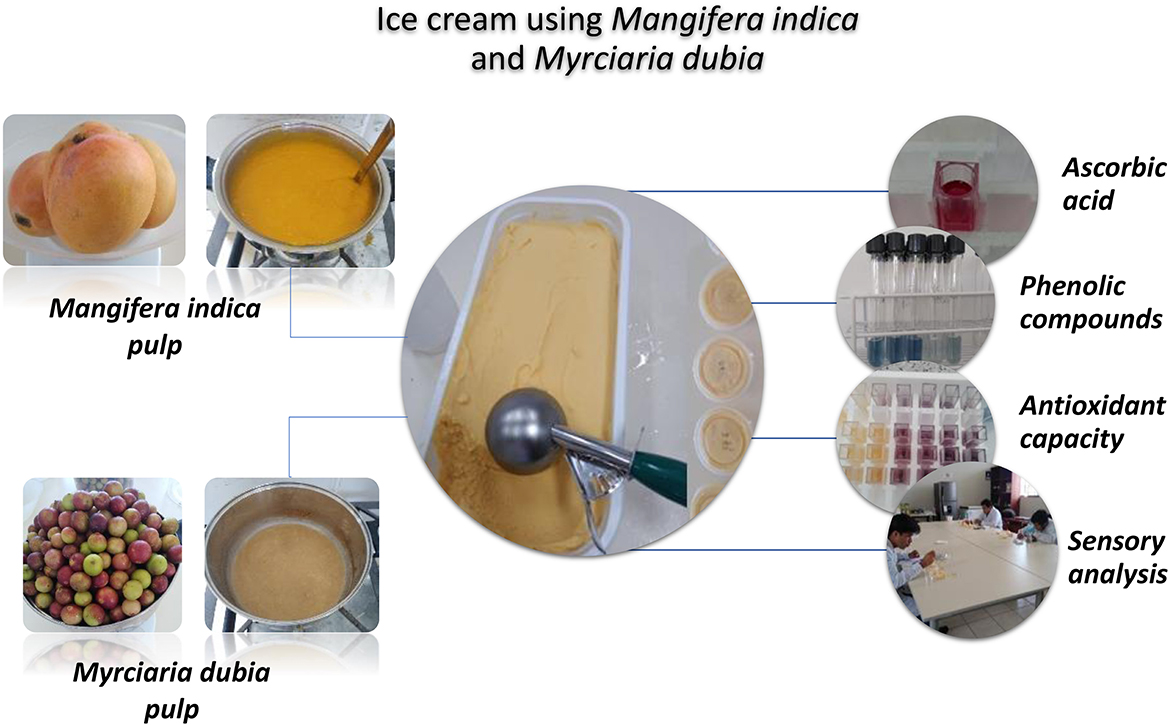
Graphical Abstract. Schematic diagram of the ice cream made with Mangifera indica and Myrciaria dubia pulps, as well as the different analyses performed.
1. Introduction
Ice cream is appreciated and consumed by people of different ages and socio-economic groups, due to its sweet taste (Bekiroglu et al., 2022); although consumption is seasonal, demand for ice cream continues to rise, as evidenced by production levels in the EU exceeding 2.9 billion liters, and in the US, almost 5 billion liters by 2020 (Nalbone et al., 2022). In addition, global market sales are expected to be around USD 75 billion in 2024, which would be a 30% increase in comparison to 2017 (Genovese et al., 2022).
Standard ice cream is made from a combination of milk, sugars, fats, non-fat milk solids, stabilizers, emulsifiers, fruits or flavorings and in some cases, colorings (Durmaz et al., 2020; Espinoza et al., 2020). Of these ingredients, non-fat solids and fat are abundant components that directly influence many characteristics such as texture, stability and volume of the ice cream (López-Martínez et al., 2021). Also, these characteristics may be influenced by the addition of carboxymethyl cellulose (Espinoza et al., 2020). In addition, ice cream has highly nutritious components such as protein, some vitamins (A, D, and E) and some minerals (Ca) (Atalar et al., 2021). However, it is a very poor source of bioactive compounds (phenolic compounds, flavonoids, vitamin C, dietary fiber and others) (Virgen-Ceceña et al., 2019; Ismail et al., 2020). Therefore, fruits represent a practical way to increase the bioactive value of ice cream, as they are rich in natural antioxidant compounds, natural colorants and vitamins, and metabolites that have been shown to reduce the development of cancer and decrease risk factors for cardiovascular and degenerative diseases (Bhardwaj et al., 2022; Sharma et al., 2022). Likewise, fruits due to their dietary fiber and polysaccharide content provide increased melt resistance with little noticeable effects on viscosity and texture of ice cream (Sakr et al., 2023).
Myrciaria dubia (M. dubia), fruit widely cultivated in the Amazon region of South America, has a high content of vitamin C (Carmo et al., 2019) and other antioxidants such as phenolic compounds (Table 1) (Chirinos et al., 2010; Fidelis et al., 2020). In addition, it is an important source of essential amino acids, fatty acids and minerals (K, Fe, Se, Ca, and Mg) (Santos et al., 2022). Peru is the main exporter of M. Dubia. In 2020, 327.48 tons of different substitutes of this fruit were exported, such as flour, capsules, extract and dried fruit (Barrios Renteria et al., 2022). Similarly, Mangifera indica (M. indica), is another fruit that possesses various bioactive compounds, particularly phenolic compounds and carotenoids (Yao et al., 2020; Herrera-Cazares et al., 2021). It also contains high concentrations of vitamins (C and A) (Table 1), fiber, minerals, macronutrients and amino acids (Alañón et al., 2019; da Silva Sauthier et al., 2019). M. indica is the seventh most produced fruit in the world (Gupta et al., 2022), appreciated for its exquisite taste, nutritional and functional composition (da Silva Sauthier et al., 2019; Lebaka et al., 2021).
In literature, it has been observed that phytochemicals present in M. dubia inhibited cell growth in four cancer cell lines (Caco-2, HepG2, A549, and HCT8) without toxicity to normal cells, as well as showing an antimutagenic potential (Carmo et al., 2019). On the other hand, the bioactive compounds present in mango have shown different properties linked to their bioactivity, such as anti-neuroinflammatory (Luo et al., 2021), antioxidant activity (Herrera-Cazares et al., 2021; Marcillo-Parra et al., 2021), immunosuppressants, α-glucosidase inhibition (Gu et al., 2019), antivirals (Umar et al., 2021), anti-modulating (Anaya-Loyola et al., 2020), anti-obesogenic, anti-cancer (Gupta et al., 2022), antidiabetic (Fernández-Ochoa et al., 2020), preventing oxidative stress and consequently the onset of chronic diseases. These attributes indicate that these fruits can be used in the production of functional foods. Barrios Renteria et al. (2022) elaborated yogurt using M. dubia (5 and 10%) and M. indica (15 and 20%) and showed that the ascorbic acid content increased between 398% and 900% compared to a standard yogurt and the percentages used of M. dubia and M. indica were sensorially acceptable.
Ice creams can improve their nutritional, sensory and functional characteristics with the addition of new ingredients. For example, when adding grape by-products (Nascimento et al., 2018), pomegranate peel powder (Ismail et al., 2020), hydrolyzed egg white (López-Martínez et al., 2021), chestnuts (Espinoza et al., 2020), microalgae (Durmaz et al., 2020), olive oil (Sacchi et al., 2019), carrot concentrate (Pandey et al., 2021), herbal extract and fructooligasaccharides (Gremski et al., 2019), prebiotics (da Silva et al., 2020). However, the interaction of these new ingredients can significantly influence the stability and functional characteristics (vitamins, phytochemicals and others) of the ice cream, especially the sensory characteristics of texture and flavor, the latter being a determining factor in the choice of ice cream (Bullock et al., 2020). In this context, the objective of this research is to study the influence of the addition of M. indica and M. dubia pulp on the total ascorbic acid content, total phenolic content, antioxidant capacity and sensorial properties of ice cream.
2. Materials and methods
2.1. Material and reagents
Ripe M. indica var. Edward was provided by Agromar S.A.C (Sullana, Perú), M. dubia fruits were purchased in a local market from the Cooperativa Agroindustrial Yarinacocha (Coopay), Pucallpa, Ucayali, Perú. The fresh whole milk was purchased from the livestock establishment in the agricultural technical college, located in Sullana. The powdered milk, sugar, carboxymethylcellulose (CMC), were also purchased in the local market of Sullana (Perú).
DPPH (2,2-diphenyl-1-picrylhydrazyl), gallic acid, Folin-Ciocalteu, sodium carbonate, oxalic acid, ascorbic acid, 2,6-dichlorophenolindophenol, ethanol (99.9% purity) and methanol (99.5% purity) were obtained from Sigma-Aldrich (ACS, Lima, Perú).
2.2. Preparation of Mangifera indica and Myrciaria dubia pulp
The selected fruits, M. dubia (intermediate ripening) and M. indica (mature), were washed, disinfected by immersion in water with sodium hypochlorite at 50 ppm and manually, with the help of a knife, the peel and seed were removed. Then independently chopped pulps were homogenized with a blender for 2 min, and subjected to heat treatment boiling temperature for 10 min, then cooled until 5°C, using ice water. The pulps were stored at 5°C until they were used for ice cream preparation.
2.3. Analysis of milk and fruit pulp
In milk, the pH was analyzed using a potentiometer (Hanna Instruments, HI991001, serial N° B40848) and the density using a lactodensimeter calibrated at 15 °C, according to the methodology described by Rodrigues et al. (2020). Likewise, the methodology described by da Silva et al. (2020) to analyze pH using a potentiometer (Hanna Instruments, HI991001, #B40848) and total soluble solids through a refractometer (Yhequiomen, RHB0-90) at 20°C in Myrciaria dubia and Mangifera indica pulps.
2.4. Ice cream preparation
The four ice cream treatments were prepared using the ingredients indicated in Table 2 and the percentages considered for each pulp (15% and 20% of M. indica, as well as 5% and 10% of M. dubia) were based on the study carried out by Barrios Renteria et al. (2022). The ice cream preparation was carried out according to Espinoza et al. (2020). First, the milk powder (2%) was dissolved in fresh milk, it was heated up to 75°C and the premixed dry ingredients (sugar and CMC) were added to it with constant stirring to avoid agglutination until the mixture reached 80°C. After constant stirring, the mixture was pasteurized at 80°C for 45 seconds, cooled until 5°C using ice water and kept refrigerated (at 5°C) for 24 h. Later, the corresponding M. indica and M. dubia pulps were added for each treatment. The churning process was carried out in an ice cream machine at −8°C for 20 min. The soft ice cream was packed in polystyrene containers (100 g capacity) and stored at −22°C for hardening (Figure 1) and subsequent determination of the ascorbic acid content, total phenolic content, antioxidant capacity and sensorial analysis was completed.
2.5. Determination of ascorbic acid in ice cream
The determination of the ascorbic acid content was carried out by reduction of 2,6- dichlorophenolindophenol according to the method described by Hung and Yen (2002). Approximately 2 g of ice cream was mixed with 4 mL of 0.4% oxalic acid, the mixture was filtered through Whatman No. 2 paper and a solution was obtained. Then 200 μL of the solution were reacted with 1,800 μL 2,6 dichlorophenolindophenol and the absorbance values were recorded in a UV-Visible spectrophotometer (Genesys, S-150, 6287015), at 520 nm wavelength. For AA quantification, Equation (1) was used
The control absorbance was obtained by the reaction of 200 μL of 0.4% oxalic acid, with 1,800 μL of 2,6-dichlorophenolindophenol.
2.6. Determination of total phenolic content (TPC) in ice cream
The total phenolic content was determined according to the method reported by Cornelio-Santiago et al. (2019). To obtain the extracts, approximately 2 g of ice cream were weighed, 2 mL of methanol were added in a 10 mL capacity tube, and then they were homogenized in a Vortex mixer at 2,500 rpm for 20 min. Additionally, it was centrifuged at 4,500 rpm for 20 min and the supernatant was removed. With the residue obtained, the aforementioned steps were repeated, obtaining a second supernatant. The two supernatants were mixed, and 1 mL of distilled water was added, finally centrifuged at 2,500 rpm for 2 min, the methanolic extract (ME) was refrigerated until use.
Later, 1.364 mL of distilled water were mixed in a test tube with 0.3 mL of methanolic extract, which reacted with 136 μL of Folin-Ciocalteu reagent, the resulting solution was left to stand at room temperature for 8 min in a dark room. Then, 1.2 mL of 7.5% Na2CO3 were added, the reaction was completed after standing for 2 h in the dark at room temperature, observing a dark blue color. Absorbance was recorded on a UV-Visible spectrophotometer (Genesys, S-150, 6287015) at 760 nm. The blank was prepared in the same way, replacing the methanolic extract with 0.3 mL of methanol and water (80:20, v/v). The TPC was calculated using the gallic acid calibration curve at the concentrations of 10, 20, 30, 40, 50 and 60 mg/L.
2.7. Determination of antioxidant capacity in ice cream
The antioxidant capacity was determined by the method of 1,1-diphenyl-2-picrylhydrazyl picrilhidrazil (Tian et al., 2018). The array comprised the combination of 100 uL of ME obtained with 2 mL of DPPH solution (0.8 mmol/L, solution in absolute ethanol), the reaction was completed after 10 min of rest at room temperature, the absorbance was read at 517 nm using a UV-Visible spectrophotometer (Genesys 150, 6287015). The percentage of inhibition was calculated using Equation (2).
To express in IC50, the same test is carried out working with different concentrations of the extract (120, 100, 50, 25, 12, 6 mg/ml). The standard reaction required the combination of 100 uL of 80% methanol with 2 mL of absolute ethanol.
Where:
Abs control: absorbance of the DPPH solution at 0.8 mmol/L.
Abs sample: sample absorbance after 10 min.
2.8. Sensorial analysis
The sensorial evaluation was carried out by 40 semi-trained panelists (10 women and 30 men) whose ages ranged from 18 to 73 years. The evaluation took place between 10:00 a.m. and 12:30 p.m. inside the Functional Foods and Bioprocesses laboratory at the Universidad Nacional de Frontera. Ice cream samples between 80 and 100 g were delivered in disposable plastic containers at −5°C, previously coded with 3-digit random numbers. The four ice cream treatments and commercial mango ice cream were subjected to a 4-attribute preference or ranking test (flavor, texture, color and general preference) using a scale between 1 and 5 (1 = least preferred and 5 = most preferred) (Rogers, 2010; Espinoza et al., 2020).
2.9. Experimental design and statistical analysis
The four ice cream treatments were prepared using a 22 completely randomized two-factorial design with two variables (M. indica and M. dubia) and with two levels in each case (15% and 20% of M. indica, as well as 5% and 10% of M. dubia) and as control, a commercial mango ice cream was used. The statistical model proposed according to Montgomery and Runger (2010) is the following:
Where, Yij denotes any of the observations, μ is the Population mean, αi is the Effect of the i-th α (different M. indica ice cream formulations), Bj is the Effect of the j-th b (different M. dubia ice cream formulations), (αβ)ij is the interaction effect of factor α and factor β (different formulations of M. indica and M. dubia ice cream), εij is the Error effect.
The values were collected in triplicate and the data obtained from each the experiment were subjected to an analysis of variance (ANOVA), and Tukey's multiple comparison test, at a confidence level of 95%. The effects of the addition of M. indica pulp and M. dubia on the response variables studied were also identified. Statistical analyses were performed with STATGRAPHICS software (StatPoint, Inc. v.16.1.03). The curves were drawn by Microsoft Excel MSO (version 2019; 16.0.10390.20024; Microsoft Office Standard 2019).
3. Results and discussion
3.1. Milk and Mangifera indica and Myrciaria dubia pulp analysis
Table 3 shows the results of the routine analyses carried out on the fruit pulp and the milk used to make the ice cream. The density and pH values of the milk complied with the quality limits for fresh milk established by Peruvian regulations (Instituto Nacional de Calidad, 2016).
The pH and the content of sugars in the fruits are important factors to take into account when carrying out the treatments, since they directly influence the sweet and acid taste of the product. It is observed that the pH of M. indica was higher than that reported by previous studies, which were between 3.8 to 4.7 (Musyimi, 2013). The content was between 10 to 20% higher for ripe M. indica (Lawson et al., 2019). Regarding M. dubia, higher values of pH (3.24) and soluble solids (7.20 °Brix) have been reported (Rodrigues et al., 2020) to those obtained in this study. These variations are attributed to the variety of the fruit, the weather conditions and agricultural practices (Bekele et al., 2020).
3.2. pH and soluble solids of ice creams using Mangifera indica and Myrciaria dubia
Table 3 shows the results of pH and soluble solids of the formulated ice creams. The pH values ranged between 4.24 and 4.53, while the soluble solids were between 16 and 18 °Brix. The control ice cream had a very close pH value (4.11); however, the soluble solids content was much higher (25 °Brix). The pH values were close to those reported in similar studies on ice cream with the addition of grape by-product powder (pH = 4.52–4.54) (Nascimento et al., 2018). In ice creams with the addition of 20 to 61% of M. dubia pulp, the soluble solids were around 24 to 51.30%, while the pH values ranged from 3.71 to 4.42; the higher the % of M. dubia, the lower the pH (Grigio et al., 2019). In the same way, an ice cream made with 50% soursop pulp, presented a soluble solids content of 22.70 °Brix (Virgen-Ceceña et al., 2019). It is important to consider that the high acidity and consequently a low pH value, generates higher viscosity, makes it difficult to shake, affects the stability of the mixture and generates protein denaturation, which affects the texture of the ice cream (Ismail et al., 2020).
3.3. Ascorbic acid in ice cream
Table 4 shows the results of the ascorbic acid content of the four ice cream treatments and the control. Ascorbic acid (AA) content was found in the range of 42.33–83.46 mg/100 g of ice cream; values well above the control (1.61 mg/100 g of ice cream). In the main effects analysis for AA content in ice cream treatments (Figure 2), it was evidenced that M. dubia pulp (PMd, %), M. indica pulp (PMi, %) and the interaction PMi x PMd significantly influence the AA content. Basically, those samples whose content in M. dubia was higher (T2 and T4), presented an increase of 98% and 69% in the content of ascorbic acid, respectively. This behavior was attributed to the high AA content of M. dubia between 1.7 to 6.11g/100 g of fresh pulp (Santos et al., 2022), higher content than that shown by M. indica (4.10–92.8 mg/100 g) (Gentile et al., 2019; Qureshi et al., 2020; Gupta et al., 2022). In addition, the AA present in the pulp of M. indica could be degraded by the pasteurization treatment. It has been reported that high temperature conditions favor the oxidation of ascorbic acid to dehydroascorbic acid, followed by hydrolysis to 2,3-diketogulonic acid and, finally, polymerization to other nutritionally inactive components (Bekele et al., 2020), which would explain the little significance of the addition of M. indica on AA in the different ice cream formulations. In a study carried out on frozen popsicles, 27% of M. dubia pulp was added, finding 84 mg of AA per 100 g of sample. However, in the present study, 17% less pulp was used to achieve a similar concentration of AA (T2), attributable to the origin of the fruits and possibly AA degradation by various factors (temperature, pH, enzymes, light and oxygen) (Grigio et al., 2019). Similarly, the content of ascorbic acid in yogurt and frozen dessert using 15% and 50% soursop pulp was between 11.25 and 9.84 mg/100g. In each case, a content of AA below our findings, the consumption of 100 g of frozen dessert would only provide between 10 and 13% of the Dietary Reference Intake (DRI) of AA for men and women. However, the T2 treatment of the present study would provide between 93.3% and 100% of the DRI, respectively (Virgen-Ceceña et al., 2019).

Table 4. Ascorbic acid content, total phenolics and antioxidant capacity in ice creams with Mangifera indica and Myrciaria dubia pulps.
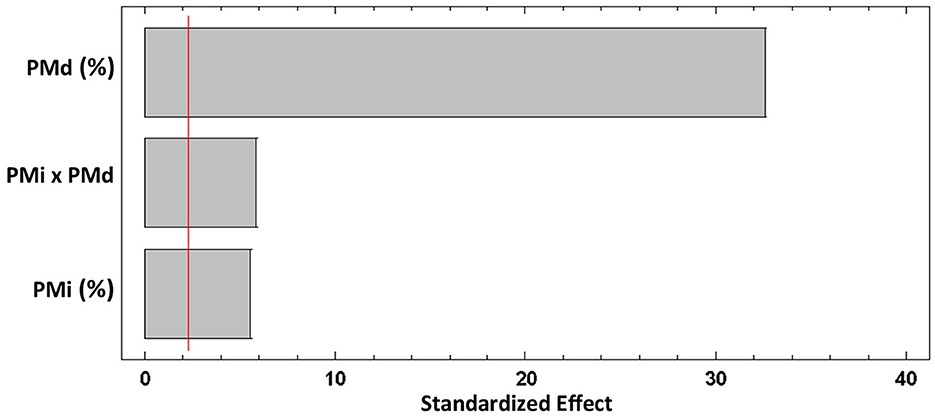
Figure 2. Pareto diagram shows the effect of the percentage of M. indica and M. dubia pulp in the ascorbic acid content of ice cream. PMd, M. dudia pulp; PMi, M. indica pulp.
3.4. Total phenolic content (TPC) in ice cream
The TPC is shown in Table 4. The TPC for all treatments ranged from 41.23 to 80.10 mg GAE/100 g of ice cream, values higher than those found in the control (3.64 mg/100 g of ice cream). All treatments were statistically different. T2 and T4 were the treatments with the highest phenolic content. The low TPC of the control may be due to the low mango incorporation and the few phenolic compounds present in the milk from the cows' diet. However, the heat treatment leading to the Maillard reaction could favor the increase in TPC (Pandey et al., 2021).
According to the analysis of the main effects in Figure 3, the PMd (%), PMi (%) and PMd x PMi, affect the TPC of the different treatments, the addition of PMd exerts the greatest influence on the TPC in the treatments of ice cream depending on the added doses. Studies reported an increase in TPC (0.7 to 4.4 mg GAE/g) as the percentage of substitution of wheat flour by powder of by-products of M. dubia increased (0 to 20%) in cookie production (das Chagas et al., 2021). Similar behavior was found in yogurt enriched with M. dubia seed extract, where the sensorially accepted sample (0.25 g/100 g of extract) with respect to the TPC, showed about 20 mgGAE/100 g, values exceeded by all treatments of the present study (Fidelis et al., 2020). In the same way, the incorporation of black carrot concentrate (7.5%), produced ice creams with TPC of 513.67 mgGAE/100 g. It is highlighted that the carrot concentrate presented 30 times more TPC than the fresh roots, which supports the high TPC values shown in the ice cream (Pandey et al., 2021). In the literature, the degradation of TPC is observed during storage at −22 °C, after 30 and 72 days, reducing between 10 and 80% of TPC in samples of ice cream enriched with herbal extracts (mate and lemon balm), which suggests a short life span for this type of product (Gremski et al., 2019).
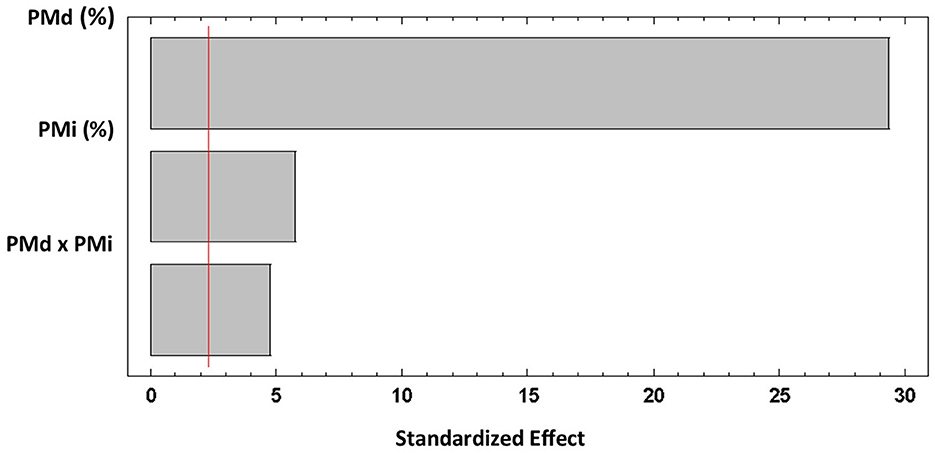
Figure 3. Pareto diagram shows the effect of the percentage of M. indica and M. dubia pulp on the total phenolic content of ice cream. PMd, M. dudia pulp; PMi, M. indica pulp.
3.5. Antioxidant capacity in ice cream
The antioxidant capacity (AC), is an important parameter that determines the potential to sequester and extinguish free radicals. The AC values found for the different ice cream treatments, expressed in IC50 (mg/mL), were higher than 60 mg/mL, as seen in Table 4. The control sample exhibited the lowest DPPH radical scavenging power, requiring 2.5 times more samples compared to ice cream formulations with M. indica and M. dubia pulps.
Consequently, all the treatments were statistically different. According to the Pareto diagram for the main effects in Figure 4, both PMd, PMi, PMd x PMi showed a significant effect at 95% confidence, in which the greatest influence was exerted by the addition of PMd, and to a lesser extent the PMd x PMi interaction, M. indica by itself, showed a minor influence. Similar results have been observed in ice cream made with the addition of black carrot concentrate (CZ), in which the higher the CZ, the CA increased (Pandey et al., 2021). In the same way, the addition of M. dubia seed extract in a dairy product (Fidelis et al., 2020). The values of the correlation analysis between TPC vs CA and AA vs CA are shown in Figure 5. As can be seen, the P-value is 0.000 < 0.05; demonstrating that there is a relationship between TPC and AA with the CA of the ice cream. The correlation for both variables (TPC vs. CA and AA vs. CA) was negative; because a higher content of these compounds led to a lower antioxidant capacity value (expressed as IC50). These findings are consistent with the results of ice cream made with hazelnut milk, which showed a positive correlation between TPC and CA (Atalar et al., 2021). Study shows antioxidant effects of an ice cream using cocoa, hazelnut extract and green tea. After the consumption of the ice cream, a reduction in oxidative stress and a greater availability of nitric oxide were observed, which improves the vascular function, due to the influence on arterial dilation and increased physical performance of healthy subjects. From this approach it is proposed that the synergy of different ingredients improves the antioxidant capacity of the final product, unlike using a single source of antioxidants. Another aspect to consider is that the bioavailability of phenolic compounds and other bioactive compounds from natural sources is greater than that of supplements (Sanguigni et al., 2017).
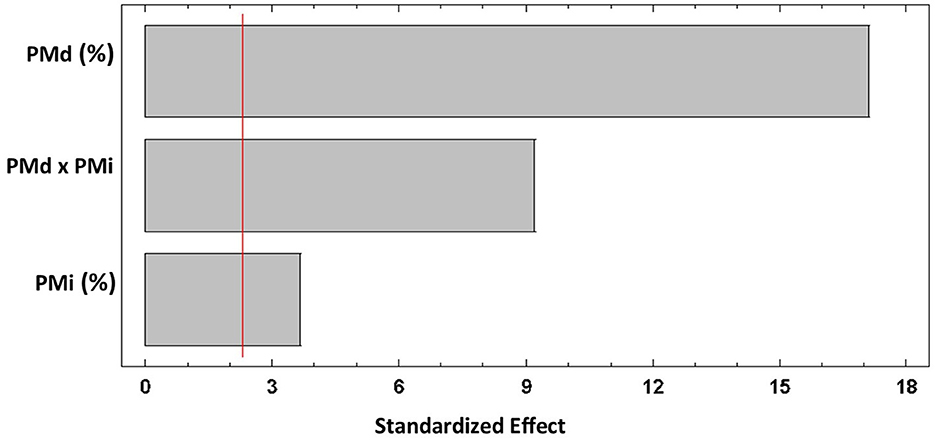
Figure 4. Pareto diagram shows the effect of the percentage of pulp M. indica and M. dubia on the antioxidant capacity of ice cream. PMd, M. dudia pulp; PMi, M. indica pulp.
3.6. Sensorial analysis
Figure 6 shows the results of the sensory evaluation of the ice cream. The organoleptic characteristics for the different attributes such as taste, texture, color and overall preference show significant differences between the different treatments. Two of the ice creams (T3 and T4) were the most preferred by the panelists. On the other hand, T1 and T2 showed no differences with respect to the control ice cream. In terms of taste, T1 and T2 ice creams were comparable to the control; however, T2 and T4 ice creams were perceived as less sweet than the others. On the other hand, three of the ice creams (T1, T2, and T3) were significantly milder than the control and T4. And as for the predominant color in the four ice creams developed, it corresponded to the natural color provided by the fruits. Therefore, the control ice cream received a better assessment by showing greater intensity of the yellow-orange color.
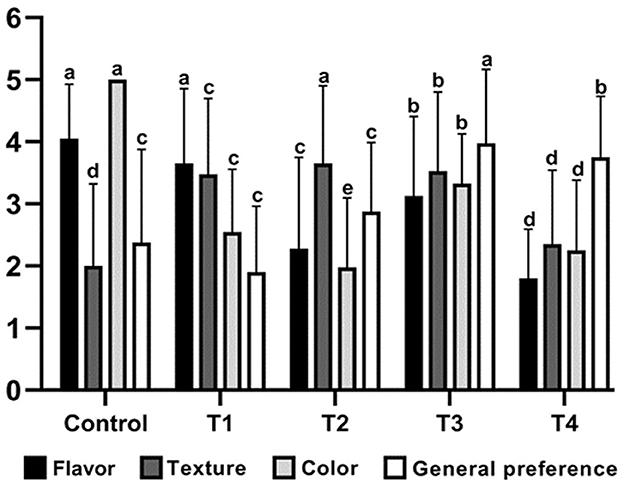
Figure 6. Sensory preferences of ice cream samples. *a, b, c, d, e: Different letters for each sensory attribute indicate significant difference between treatments. Treatment 1: 15% M. indica and 5% M. dubia; Treatment 2: 15% M. indica and 10% M. dubia; Treatment 3: 20% M. indica and 5% M. dubia; Treatment 4: 20% M. indica and 10% M. dubia; Control: Commercial mango ice cream.
It was observed that the appreciation of the sweet taste of ice cream tends to decrease when the amount of M. dubia pulp is increased from 5 to 10%. This effect may be due to the increase of the characteristic sour taste of the fruit. A similar effect was demonstrated by Grigio et al. (2019); however, higher sweetness scores were also linked to higher sugar addition.
Ice creams containing 20% (T1 and T2) to 25% (T3) of added fruit showed a softer texture. Despite the fact that no milk fat is added in the development of the ice creams, the creaminess of the ice creams (T1, T2, and T3) was superior to the control ice cream. The fruit pulp contributes to improving the texture of the ice cream. Moreover, it intensifies the flavor and expands the smell of the ice cream, even during storage (Kowalczyk et al., 2021). On the other hand, the addition of CMC played an important role in the stabilization of the ice cream texture, as it simulates the physical properties of fat provided by its water retention capacity, gel formation and thickener function (Regand and Goff, 2002). The use of hydrocolloids in ice cream has improved the inhibition of recrystallisation, reduced the melting speed, improved the stability of the ingredients in the mixture, increased the viscosity and the overrun rate (Kamińska-Dwórznicka et al., 2022).
Probably the presence of yellow-orange coloring in the control ice cream led to better evaluations by the panelists. However, there was a greater preference for the ice creams with a higher percentage of added M. indica. Consequently, the ice cream with 20% M. indica and 5% M. dubia (T3), was the best rated against the other ice creams. The interaction of sweet-acid taste in this ice cream was very pleasant, which even surpassed the control in some organoleptic characteristics.
4. Conclusion
This study has shown that the addition of Myrciaria dubia (5% and 10%) and Mangifera indica (20%) pulp could be used as a valid ingredient in the production of sensorially acceptable, functional ice creams. M. dubia pulp significantly influenced ascorbic acid content (42.33–83.46 mg/100 g), total phenolic content (41.23–80.10 mg GAE/100 g) and antioxidant capacity (61–67 mg ice cream/ml solvent), and M. indica pulp positively influenced sensory characteristics. For a possible commercialization, a study of shelf life, microbiological analysis and nutritional value would be necessary. Also, it is interesting to study the profile of volatile compounds and the level of bio-digestibility.
Data availability statement
The original contributions presented in the study are included in the article/supplementary material, further inquiries can be directed to the corresponding author.
Author contributions
EM-S: conceptualization, investigation, and preparation of the original draft. LE-E: conceptualization, funding acquisition, supervision, and revision. LR-F: investigation, writing, and formal analysis. JV-M: investigation and visualization. LM-Q: data curation, review, and visualization. HC-S: methodology, data curation, and review. All authors contributed to the article and approved the version submitted.
Funding
This research received financial support from the Universidad Nacional de Frontera, Peru. Resolution No. 069-2020-CO, Resolution No. 405-2022-UNF/FCET, and Agreement No. 002-2020-UNF.
Acknowledgments
We thank the volunteers who participated in the sensory analysis and the laboratory staff of the Universidad Nacional de Frontera.
Conflict of interest
The authors declare that the research was conducted in the absence of any commercial or financial relationships that could be construed as a potential conflict of interest.
Publisher's note
All claims expressed in this article are solely those of the authors and do not necessarily represent those of their affiliated organizations, or those of the publisher, the editors and the reviewers. Any product that may be evaluated in this article, or claim that may be made by its manufacturer, is not guaranteed or endorsed by the publisher.
References
Alañón, M. E., Oliver-Simancas, R., Gómez-Caravaca, A. M., Arráez-Román, D., and Segura-Carretero, A. (2019). Evolution of bioactive compounds of three mango cultivars (Mangifera indica L.) at different maturation stages analyzed by HPLC-DAD-q-TOF-MS. Food Res. Int. 125, 108526. doi: 10.1016/j.foodres.2019.108526
Anaya-Loyola, M. A., García-Marín, G., García-Gutiérrez, D. G., Castaño-Tostado, E., Reynoso-Camacho, R., López-Ramos, J. E., et al. (2020). A mango (Mangifera indica L.) juice by-product reduces gastrointestinal and upper respiratory tract infection symptoms in children. Food Res. Int. 136, 109492. doi: 10.1016/j.foodres.2020.109492
Atalar, I., Kurt, A., Gul, O., and Yazici, F. (2021). Improved physicochemical, rheological and bioactive properties of ice cream: Enrichment with high pressure homogenized hazelnut milk. Int. J. Gastron. Food Sci. 24, 100358. doi: 10.1016/j.ijgfs.2021.100358
Barrios Renteria, J. C., Espinoza-Espinoza, L. A., Valdiviezo-Marcelo, J., and Moreno-Quispe, L. A. (2022). Sensorially accepted Mangifera indica and Myrciaria dubia yogurts with high ascorbic acid content. Front. Sustain. Food Syst. 6, 999400. doi: 10.3389/fsufs.2022.999400
Bekele, M., Satheesh, N., and Sadik, J. A. M. (2020). Screening of Ethiopian mango cultivars for suitability for preparing jam and determination of pectin, sugar, and acid effects on physico-chemical and sensory properties of mango jam. Sci. African. 7, e00277. doi: 10.1016/j.sciaf.2020.e00277
Bekiroglu, H., Goktas, H., Karaibrahim, D., Bozkurt, F., and Sagdic, O. (2022). Determination of rheological, melting and sensorial properties and volatile compounds of vegan ice cream produced with fresh and dried walnut milk. Int. J. Gastron. Food Sci. 28, 100521. doi: 10.1016/j.ijgfs.2022.100521
Bhardwaj, K., Najda, A., Sharma, R., Nurzy, R., Dhanjal, D. S., Sharma, R., et al. (2022). Fruit and vegetable peel-enriched functional foods : potential avenues and health. Perspectives. 2022. doi: 10.1155/2022/8543881
Bullock, K., Lahne, J., and Pope, L. (2020). Investigating the role of health halos and reactance in ice cream choice. Food Qual. Prefer. 80, 103826. doi: 10.1016/j.foodqual.2019.103826
Camargo, L., Xavier, V., Alves, J., Flach, A., and Ruffo, S. (2015). Scientia Horticulturae Bioactive compounds and antioxidant activity in pre-harvest camu-camu [Myrciaria dubia (H. B. K.) Mc Vaugh] fruits. Sci. Hortic. (Amsterdam). 186, 223–229. doi: 10.1016/j.scienta.2015.02.031
Carmo, M. A. V., Do, F. M., Pressete, C. G., Marques, M. J., Castro-Gamero, A. M., Myoda, T., et al. (2019). Hydroalcoholic Myrciaria dubia (camu-camu) seed extracts prevent chromosome damage and act as antioxidant and cytotoxic agents. Food Res. Int. 125, 108551. doi: 10.1016/j.foodres.2019.108551
Chirinos, R., Galarza, J., Betalleluz-Pallardel, I., Pedreschi, R., and Campos, D. (2010). Antioxidant compounds and antioxidant capacity of Peruvian camu camu (Myrciaria dubia (H.B.K.) McVaugh) fruit at different maturity stages. Food Chem. 120, 1019–1024. doi: 10.1016/j.foodchem.2009.11.041
Cornelio-Santiago, H. P., Mazalli, M. R., Rodrigues, C. E. C., and de Oliveira, A. L. (2019). Extraction of Brazil nut kernel oil using green solvents: Effects of the process variables in the oil yield and composition. J. Food Process Eng. 42, 1–11. doi: 10.1111/jfpe.13271
da Silva Sauthier, M. C., da Silva, E. G. P., da Silva Santos, B. R., Silva, E. F. R., da Cruz Caldas, J., Cavalcante Minho, L. A., et al. (2019). Screening of Mangifera indica L. functional content using PCA and neural networks (ANN). Food Chem. 273, 115–123. doi: 10.1016/j.foodchem.2018.01.129
da Silva, J. M., Klososki, S. J., Silva, R., Raices, R. S. L., Silva, M. C., Freitas, M. Q., et al. (2020). Passion fruit-flavored ice cream processed with water-soluble extract of rice by-product: what is the impact of the addition of different prebiotic components? Lwt 128, 109472. doi: 10.1016/j.lwt.2020.109472
das Chagas, E. G. L., Vanin, F. M., dos Santos Garcia, V. A., Yoshida, C. M. P., and de Carvalho, R. A. (2021). Enrichment of antioxidants compounds in cookies produced with camu-camu (Myrciaria dubia) coproducts powders. LWT. 137, 110472. doi: 10.1016/j.lwt.2020.110472
Durmaz, Y., Kilicli, M., Toker, O. S., Konar, N., Palabiyik, I., and Tamtürk, F. (2020). Using spray-dried microalgae in ice cream formulation as a natural colorant: effect on physicochemical and functional properties. Algal Res. 47, 101834. doi: 10.1016/j.algal.2020.101811
Espinoza, L. A., Purriños, L., Centeno, J. A., and Carballo, J. (2020). Chemical, microbial and sensory properties of a chestnut and milk ice cream with improved healthy characteristics. Int. J. Food Prop. 23, 2271–2294. doi: 10.1080/10942912.2020.1856135
Fernández-Ochoa, Á., Cázares-Camacho, R., Borrás-Linares, I., Domínguez-Avila, J. A., Segura-Carretero, A., and González-Aguilar, G. A. (2020). Evaluation of metabolic changes in liver and serum of streptozotocin-induced diabetic rats after Mango diet supplementation. J. Funct. Foods. 64, 103695. doi: 10.1016/j.jff.2019.103695
Fidelis, M., do Carmo, M. A. V., da Cruz, T. M., Azevedo, L., Myoda, T., Miranda Furtado, M., et al. (2020). Camu-camu seed (Myrciaria dubia)—from side stream to an antioxidant, antihyperglycemic, antiproliferative, antimicrobial, antihemolytic, anti-inflammatory, and antihypertensive ingredient. Food Chem. 310, 125909. doi: 10.1016/j.foodchem.2019.125909
Genovese, A., Balivo, A., Salvati, A., and Sacchi, R. (2022). Functional ice cream health benefits and sensory implications. Food Res. Int. 161, 111858. doi: 10.1016/j.foodres.2022.111858
Gentile, C., Di Gregorio, E., Di Stefano, V., Mannino, G., Perrone, A., Avellone, G., et al. (2019). Food quality and nutraceutical value of nine cultivars of mango (Mangifera indica L.) fruits grown in Mediterranean subtropical environment. Food Chem. 277, 471–479. doi: 10.1016/j.foodchem.2018.10.109
Gremski, L. A., Coelho, A. L. K., Santos, J. S., Daguer, H., Molognoni, L., do Prado-Silva, L., et al. (2019). Antioxidants-rich ice cream containing herbal extracts and fructooligossaccharides: manufacture, functional and sensory properties. Food Chem. 298, 125098. doi: 10.1016/j.foodchem.2019.125098
Grigio, M. L., Durigan, M. F. B., and Chagas, E. A. (2019). Different formulations of camu-camu popsicle: characterization, vitamin C and sensorial analysis of an opportunity to family agroindustry. Food Sci. Technol. 39, 93–97. doi: 10.1590/fst.38417
Gu, C., Yang, M., Zhou, Z., Khan, A., Cao, J., and Cheng, G. (2019). Purification and characterization of four benzophenone derivatives from Mangifera indica L. leaves and their antioxidant, immunosuppressive and α-glucosidase inhibitory activities. J. Funct. Foods 52, 709–714. doi: 10.1016/j.jff.2018.11.045
Gupta, A. K., Gurjar, P. S., Beer, K., Pongener, A., Ravi, S. C., Singh, S., et al. (2022). A review on valorization of different byproducts of mango (Mangifera indica L.) for functional food and human health. Food Biosci. 48, 101783. doi: 10.1016/j.fbio.2022.101783
Herrera-Cazares, L. A., Ramírez-Jiménez, A. K., Luzardo-Ocampo, I., Antunes-Ricardo, M., Loarca-Piña, G., Wall-Medrano, A., et al. (2021). Gastrointestinal metabolism of monomeric and polymeric polyphenols from mango (Mangifera indica L.) bagasse under simulated conditions. Food Chem. 365. doi: 10.1016/j.foodchem.2021.130528
Hung, C. Y., and Yen, G. C. (2002). Antioxidant activity of phenolic compounds isolated from Mesona procumbens Hemsl. J. Agric. Food Chem. 50, 2993–2997. doi: 10.1021/jf011454y
Instituto Nacional de Calidad (2016). Leche y productos lácteos. Leche cruda. Requisitos 6ta Edición. Available online at: https://www.inacal.gob.pe/cid/categoria/normas-tecnicas-peruanas (accessed October 18, 2022).
Ismail, H. A., Hameed, A. M., Refaey, M. M., Sayqal, A., and Aly, A. A. (2020). Rheological, physio-chemical and organoleptic characteristics of ice cream enriched with Doum syrup and pomegranate peel. Arab. J. Chem. 13, 7346–7356. doi: 10.1016/j.arabjc.2020.08.012
Kamińska-Dwórznicka, A., Łaba, S., and Jakubczyk, E. (2022). The effects of selected stabilizers addition on physical properties and changes in crystal structure of whey ice cream. LWT. 154, 112841. doi: 10.1016/j.lwt.2021.112841
Kowalczyk, M., Znamirowska, A., and Buniowska, M. (2021). Probiotic sheep milk ice cream with inulin and apple fiber. Foods. 10, 678. doi: 10.3390/foods10030678
Lawson, T., Lycett, G. W., Ali, A., and Chin, C. F. (2019). Characterization of Southeast Asia mangoes (Mangifera indica L) according to their physicochemical attributes. Sci. Hortic. (Amsterdam). 243, 189–196. doi: 10.1016/j.scienta.2018.08.014
Lebaka, V. R., Wee, Y. J., Ye, W., and Korivi, M. (2021). Nutritional composition and bioactive compounds in three different parts of mango fruit. Int. J. Environ. Res. Public Health 18, 1–20. doi: 10.3390/ijerph18020741
López-Martínez, M. I., Moreno-Fernández, S., and Miguel, M. (2021). Development of functional ice cream with egg white hydrolysates. Int. J. Gastron. Food Sci. 25. doi: 10.1016/j.ijgfs.2021.100334
Luo, L., Wang, Y., Wang, Y., Xu, J., and He, X. (2021). Potential in vitro anti-neuroinflammatory sterols from mango fruits (Mangifera indica L.). J. Funct. Foods 84, 104576. doi: 10.1016/j.jff.2021.104576
Marcillo-Parra, V., Anaguano, M., Molina, M., Tupuna-Yerovi, D. S., and Ruales, J. (2021). Characterization and quantification of bioactive compounds and antioxidant activity in three different varieties of mango (Mangifera indica L.) peel from the Ecuadorian region using HPLC-UV/VIS and UPLC-PDA. NFS J. 23, 1–7. doi: 10.1016/j.nfs.2021.02.001
Montgomery, D. C., and Runger, G. C. (2010). Applied Statistics and Probability for Engineers. New York, NY: John Wiley & Sons.
Musyimi, S. M. (2013). Production and Characterization of Mango (Mangifera indica) Fruit Wine (Dissertation/Master's thesis). Jomo Kenyatta University of Agriculture and Technology, Juja, Kenya.
Nalbone, L., Vallone, L., Giarratana, F., Virgone, G., Lamberta, F., Marotta, S. M., et al. (2022). Applied sciences Microbial Risk Assessment of Industrial Ice Cream Marketed in Italy. doi: 10.3390/app12041988
Nascimento, E., de, A., de A. Melo, E., and Lima, V. L. (2018). Ice cream with functional potential added grape agro-industrial waste. J. Culin. Sci. Technol. 16, 128–148. doi: 10.1080/15428052.2017.1363107
Ndlela, S., Obala, F., Mwando, N. L., Mkiga, A. M., Azrag, A. G. A., and Mohamed, S. A. (2022). Hot water disinfestation treatment does not affect physical and biochemical properties of export quality mango fruit [mangifera indica l.]. Agriculture. 12, 570. doi: 10.3390/agriculture12050570
Pandey, P., Grover, K., Dhillon, T. S., Kaur, A., and Javed, M. (2021). Evaluation of polyphenols enriched dairy products developed by incorporating black carrot (Daucus carota L.) concentrate. Heliyon.7, e06880. doi: 10.1016/j.heliyon.2021.e06880
Qureshi, T. M., Nadeem, M., Maken, F., Tayyaba, A., Majeed, H., and Munir, M. (2020). Influence of ultrasound on the functional characteristics of indigenous varieties of mango (Mangifera indica L.). Ultrason. Sonochem. 64, 104987. doi: 10.1016/j.ultsonch.2020.104987
Regand, A., and Goff, H. D. (2002). Effect of biopolymers on structure and ice recrystallization in dynamically frozen ice cream model systems. J. Dairy Sci. 85, 2722–2732. doi: 10.3168/jds.S0022-0302(02)74359-2
Rodrigues, L. M., Romanini, E. B., Silva, E., Pilau, E. J., da Costa, S. C., and Madrona, G. S. (2020). Camu-camu bioactive compounds extraction by ecofriendly sequential processes (ultrasound assisted extraction and reverse osmosis). Ultrason. Sonochem. 64. doi: 10.1016/j.ultsonch.2020.105017
Rogers, L. L. (2010). “Sensory methods for quality control in sensory analysis for food and beverage quality control,” in Woodhead Publishing Series in Food Science, Technology and Nutrition. p. 54–74. doi: 10.1533/9781845699512.2.51
Sacchi, R., Caporaso, N., Squadrilli, G. A., Paduano, A., Ambrosino, M. L., Cavella, S., et al. (2019). Sensory profile, biophenolic and volatile compounds of an artisanal ice cream (‘gelato') functionalised using extra virgin olive oil. Int. J. Gastron. Food Sci. 18, 100173. doi: 10.1016/j.ijgfs.2019.100173
Sakr, S. S., Mohamed, S. H. S., Ali, A. A., Ahmed, W. E., Algheshairy, R. M., Almujaydil, M. S., et al. (2023). Organoleptical Characteristics of Ice Cream Incorporating Adansonia digitata Pulp Flour. doi: 10.3390/foods12030533
Sanguigni, V., Manco, M., Sorge, R., Gnessi, L., and Francomano, D. (2017). Natural antioxidant ice cream acutely reduces oxidative stress and improves vascular function and physical performance in healthy individuals. Nutrition. 33, 225–233. doi: 10.1016/j.nut.2016.07.008
Santos, I. L., Miranda, L. C. F., da Cruz Rodrigues, A. M., da Silva, L. H. M., and Amante, E. R. (2022). Camu-camu [Myrciaria dubia (HBK) McVaugh]: A review of properties and proposals of products for integral valorization of raw material. Food Chem. 372, 131290. doi: 10.1016/j.foodchem.2021.131290
Sharma, R., Jadhav, M., Choudhary, N., Kumar, A., Rauf, A., Gundamaraju, R., et al. (2022). Deciphering the impact and mechanism of Trikatu, a spices-based formulation on alcoholic liver disease employing network pharmacology analysis and in vivo validation. Front. Nutr. 9, 1063118. doi: 10.3389/fnut.2022.1063118
Tian, X., Liu, Y., Feng, X., Khaskheli, A. A., Xiang, Y., and Huang, W. (2018). The effects of alcohol fermentation on the extraction of antioxidant compounds and flavonoids of pomelo peel. LWT - Food Sci. Technol. 89, 763–769. doi: 10.1016/j.lwt.2017.11.049
Umar, H. I., Josiah, S. S., Saliu, T. P., Jimoh, T. O., Ajayi, A., and Danjuma, J. B. (2021). In-silico analysis of the inhibition of the SARS-CoV-2 main protease by some active compounds from selected African plants. J. Taibah Univ. Med. Sci. 16, 162–176. doi: 10.1016/j.jtumed.2020.12.005
Virgen-Ceceña, L. J., Anaya-Esparza, L. M., Coria-Téllez, A. V., García-Magaña, M., de, L., García-Galindo, H. S., et al. (2019). Evaluation of nutritional characteristics and bioactive compounds of soursop-yoghurt and soursop-frozen dessert. Food Sci. Biotechnol. 28, 1337–1347. doi: 10.1007/s10068-019-00584-x
Keywords: camu camu, mango, ascorbic acid, phenolics compounds, sensorial evaluation
Citation: Mauricio-Sandoval EA, Espinoza-Espinoza LA, Ruiz-Flores LA, Valdiviezo-Marcelo J, Moreno-Quispe LA and Cornelio-Santiago HP (2023) Influence of the pulp of Mangifera indica and Myrciaria dubia on the bioactive and sensory properties of ice cream. Front. Sustain. Food Syst. 7:1126448. doi: 10.3389/fsufs.2023.1126448
Received: 17 December 2022; Accepted: 27 February 2023;
Published: 20 March 2023.
Edited by:
Monika Thakur, Amity University, IndiaReviewed by:
Naveen Kumar, Amity University Jaipur, IndiaAnkit Paliwal, Fiji National University, Fiji
Rohit Sharma, Institute of Medical Sciences, Banaras Hindu University, India
Copyright © 2023 Mauricio-Sandoval, Espinoza-Espinoza, Ruiz-Flores, Valdiviezo-Marcelo, Moreno-Quispe and Cornelio-Santiago. This is an open-access article distributed under the terms of the Creative Commons Attribution License (CC BY). The use, distribution or reproduction in other forums is permitted, provided the original author(s) and the copyright owner(s) are credited and that the original publication in this journal is cited, in accordance with accepted academic practice. No use, distribution or reproduction is permitted which does not comply with these terms.
*Correspondence: Luis Alfredo Espinoza-Espinoza, bGVzcGlub3phQHVuZi5lZHUucGU=
†These authors have contributed equally to this work and share first authorship
 Enrique Alonso Mauricio-Sandoval
Enrique Alonso Mauricio-Sandoval Luis Alfredo Espinoza-Espinoza
Luis Alfredo Espinoza-Espinoza Luis Alberto Ruiz-Flores
Luis Alberto Ruiz-Flores Jaime Valdiviezo-Marcelo
Jaime Valdiviezo-Marcelo Luz Arelis Moreno-Quispe
Luz Arelis Moreno-Quispe Heber Peleg Cornelio-Santiago
Heber Peleg Cornelio-Santiago